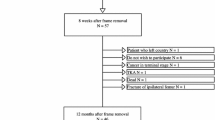Summary.
This study investigated to what extent quality of life four years or more after the fracture is determined by initial staging (Gustilo subclassification, time from injury to arrival at hospital), by the therapeutic course (length of hospital stay, number of operations), by complications (amputation, infection) and by demographic factors (gender, age). A total of 197 patients after type III open tibial shaft fractures (type IIIA 70, type IIIB 85, type IIIC 42) from nine centers volunteered to participate in this study. During patients' follow-up appointments (mean duration of follow-up 50 months), therapeutic course, pre-surgical staging and demographic data were recorded by the surgeon. Patients were asked to rate quality of life on the Nottingham Health Profile and on a visual analogue scale. Multiple regression analysis (stepwise) identified two predictors for reducing overall quality of life (F-test: P = 0.007): number of operations (adjusted beta: –0.21) and age (adjusted beta: –0.17). Other factors showed no significant relationship with overall quality of life or with subscales of the Nottingham Health Profile. These findings indicate a dilemma between two therapeutic goals: good functional outcome, which often requires repeated operations, and quality of life, which suffers under prolonged surgical treatment.
Zusammenfassung.
In dieser Multicenterstudie wurden Patienten nach Unterschenkelbrüchen Typ III nach Gustilo untersucht, um geeignete Prädiktoren zu finden, die einen Einfluß auf die später erreichte Lebensqualität haben. Es wurden traumaspezifische (Subklasssifikation nach Gustilo, Zeitspanne bis zur Einlieferung ins Zentrum) therapiespezifische (Anzahl und Dauer der stationären Behandlung, Anzahl der Operationen), komplikationsbeschreibende (Amputation oder Infektion) und demographische (Alter, Geschlecht) Faktoren untersucht. Bei einer mittleren Rücklaufrate von 66 % konnten 197 Patienten mit Unterschenkelbrüchen Typ III nach Gustilo (IIIA: 70, IIIB: 85, IIIC: 42) aus 9 Zentren an der Studie teilnehmen, die im Zeitraum von 1989 bis 1993 behandelt wurden. Der durchschnittliche Nachuntersuchungszeitraum belief sich auf 50 Monate. Es wurde ein Arztfragebogen mit therapeutischen Daten erstellt. Die Lebensqualität der Patienten wurde anhand des Nottingham Health Profils (NHP) als auch einer visuellen Analogskala beurteilt. Zwei, die Lebensqualität beeinflussende Faktoren konnten durch die multiple (schrittweise) Regressionsanalyse identifiziert werden (F-Test: p = 0,007): Anzahl der Operationen (adjusted beta: –0,21) und Alter (adjusted beta: –0,17). Die Hinzunahme weiterer Faktoren zeigte keinen statistisch signifikanten Zuwachs an Varianzaufklärung für die globale Lebensqualität oder für die Lebensqualitätsdimensionen des NHP. Diese Tatsache bedeutet ein Dilemma zwischen 2 therapeutischen Zielen: mehrfache operative Eingriffe, die zum infektfreien Erhalt erforderlich sind, wirken sich negativ auf die später erreichte Lebensqualität des Patienten aus.
Similar content being viewed by others
Author information
Authors and Affiliations
Rights and permissions
About this article
Cite this article
Knopp, W., Kugler, J., Reckert, P. et al. Determinanten der Lebensqualität nach offenem Unterschenkelbruch Typ III Ergebnisse einer Multicenterstudie*. Chirurg 68, 1156–1161 (1997). https://doi.org/10.1007/s001040050337
Issue Date:
DOI: https://doi.org/10.1007/s001040050337




